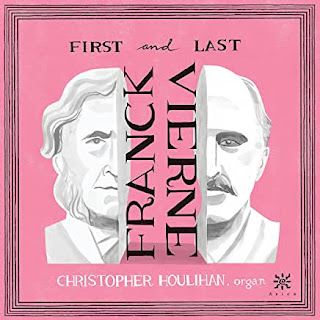by Karl Nehring
Franck and Vierne: First and Last. Franck: Grande Pièce Symphonique, op. 17; Vierne: Symphonie No. 6, op. 59. Christopher Houlihan, organ. Azica ACD-71356
The subtitle of this album is “French Romantic Organ Symphonies.” Judging from that subtitle, and as you might guess from the fact that the two compositions are sufficient to fill an entire CD, these are both substantial compositions. Sharing his inspiration behind the album, the American organist Christopher Houlihan (b. 1987) begins his liner note essay by observing “The era of French Romantic symphonic organ music is bookended by the work of two composers, César Franck (1822-1890) and Louis Vierne (1870-1937). Among this oeuvre, there are probably no two pieces that better represent the trajectory of this style than Franck’s Grande pièce symphonique and Vierne’s Symphony No. 6 – essentially the first and the last French Romantic organ symphonies.” Music lovers may well be familiar with Franck from his work in other genres, such as his symphony, chamber music, or piano music; perhaps some might even recall that he was in fact an organist, so are not surprised that he also wrote music for that mighty instrument. For many music lovers, though, the music of Vierne is much less well-known, for he specialized in music for the organ, for which he composed six of these organ symphonies. Both pieces on the program truly are grand works, the Franck in six movements and the Vierne in five. Perhaps because Vierne was the true organ specialist, it is the Franck piece that will most likely sound the more “symphonic” to the majority of classical music listeners, while the Vierne will sound more like what they would expect organ music to sound like.
First and Last was recorded on the Manton Memorial Organ “Pascal Quoirin” (2011) at the Church of the Ascension, the only French-built organ in New York. Houlihan explains the significance of playing this repertoire on the organ at Church of the Ascension: “Among organ music, the successful performance of French repertoire is especially dependent on the particular sonorities available on a given instrument. The Quoirin organ is a very good fit for the colorful demands of Franck and Vierne’s music, and it was an honor to return to Ascension Church for this recording.” I did a little research on this particular organ and found an article at the church’s website that offered some fascinating details about the history of this instrument:
The sound quality of the CD is full, warm, and natural, giving a sense of the church but without the excessive reverberation or over-emphasis on deep bass that is sometimes encountered on organ recordings. This is not a recording for those looking to show off their audio systems, it is an recording for those who enjoy good music, well performed and well-recorded. Especially for those who would like to add some organ music to their collection and are looking for something other than the usual Bach recitals, First and Last would be well worth checking out.
Holst: The Planets. Daniel Harding, Chor und Symphonieorchester des Bayerische Rundfunks (Bavarian Radio Choir and Symphony Orchestra). BR Klassik 900208
Gustav Holst’s The Planets, familiar to most music lovers through its many recordings over the years (we all have our favorites, many of us more than one) was composed between 1914 and 1916. Its seven movements comprise musical portraits of the seven known planets of Holst’s time, but based more on astrology and mysticism than astronomy and scientific fact. Each "planet" can be seen as a kind of tone poem. The unusually informative liner notes point out that Holst had originally given the suite the certainly less colorful title, Seven Pieces for Large Orchestra. (As splendid as the music is, it is hard to imagine that it would be as popular as it is today with that title.) According to the background press release information that accompanied this release, the work had not been performed by the Bavarian Radio Symphony Orchestra for almost three decades when British conductor Daniel Harding (who, fascinatingly enough, is also a commercial airline pilot) brought it back to Munich’s concert audience in February, 2022, when this live recording was made.
I can’t help wonder whether the orchestra's long period of unfamiliarity with the piece might help to explain the measured pace that Harding adopts throughout all seven movements, for this is the slowest version of The Planets that I can recall auditioning. However, that is not necessarily a bad thing, for the sound quality is top-drawer and the deliberate pacing allows the listener to savor every little detail of the score. Compare Harding’s Mars to Dutoit’s, for example, and the latter seems to be just scurrying right through it. Still, the Dutoit recording remains a favorite of mine – I am just using it as a reference point. Other favorites of mine include Mehta, Previn, Steinberg, Slatkin, and Boult. This recording is at the opposite end of the spectrum from the classic Steinberg/BSO – Steinberg tears through it, Harding takes his time. Somewhere in the middle is the 1979 Boult/LPO. Although some folks might try to dismiss The Planets as "too popular" to be taken seriously, I think it is a simply magnificent piece of serious music, one of those compositions for which auditioning and perhaps even owning multiple versions is certainly nothing of which to be ashamed. For those with a keen interest in Holst’s extraordinary score, this new Harding version is well worth a listen, for it offers both sterling sonics and a unique perspective on the music.






No comments:
Post a Comment
Thank you for your comment. It will be published after review.